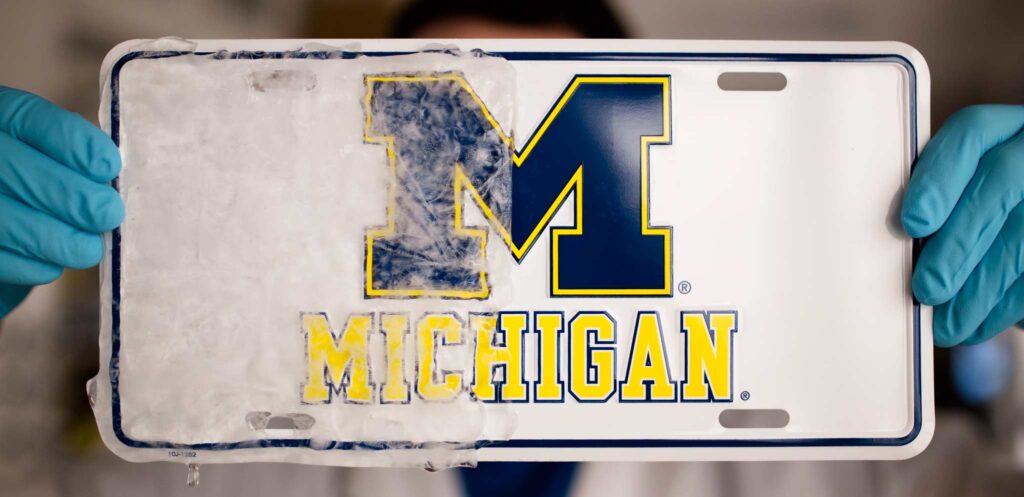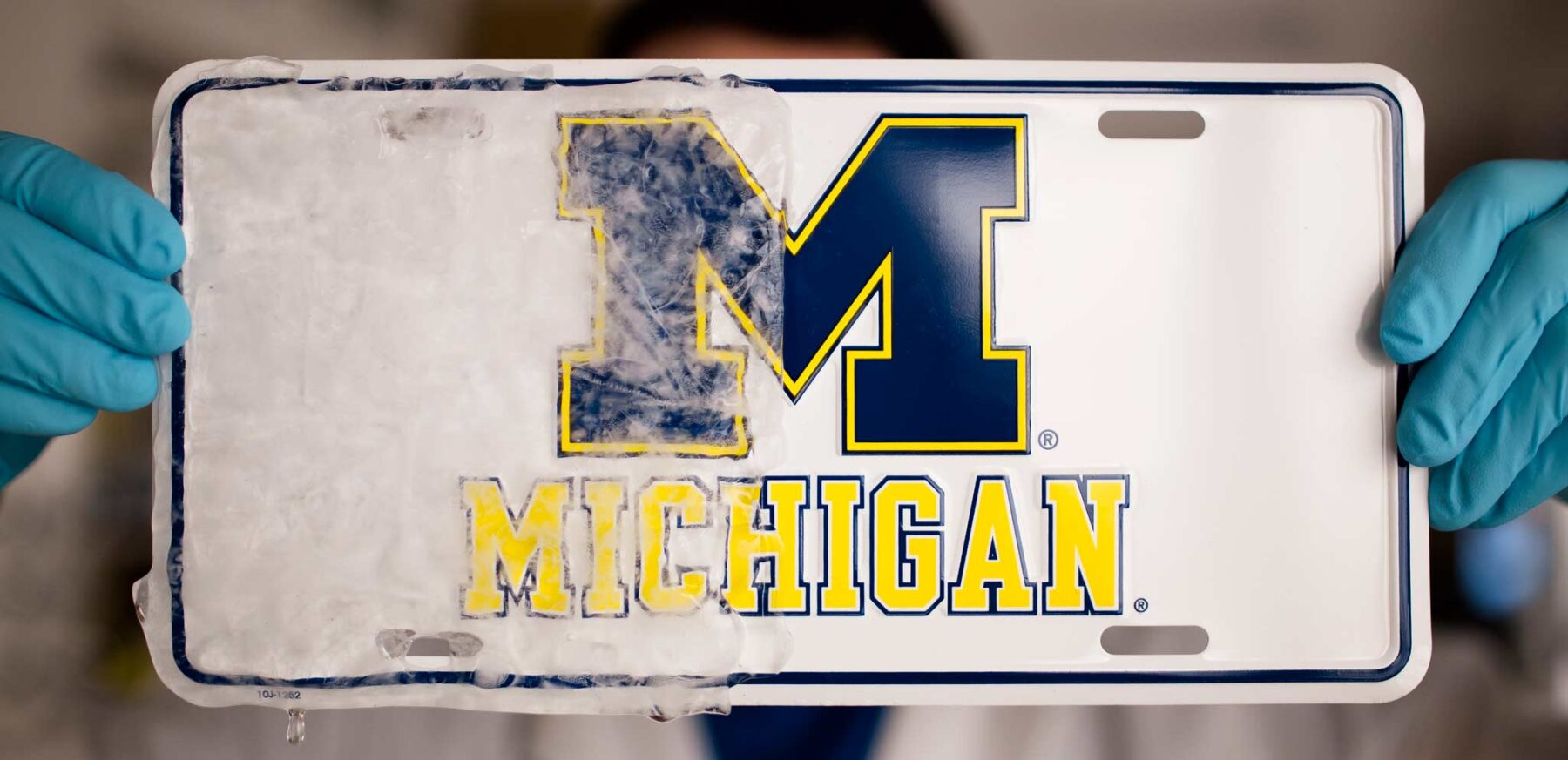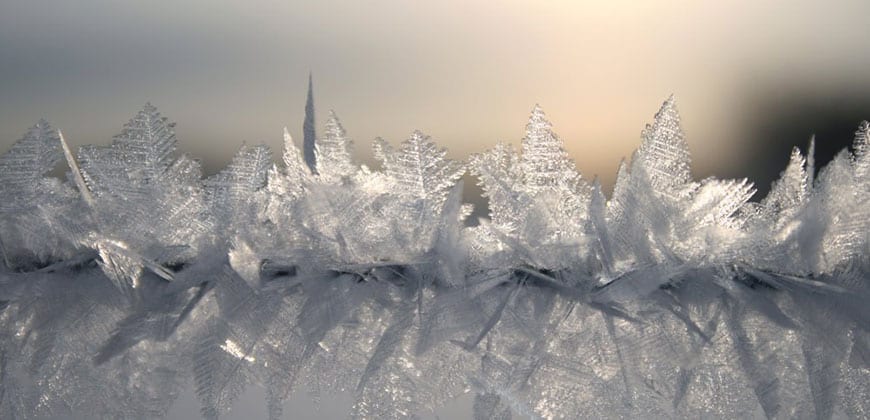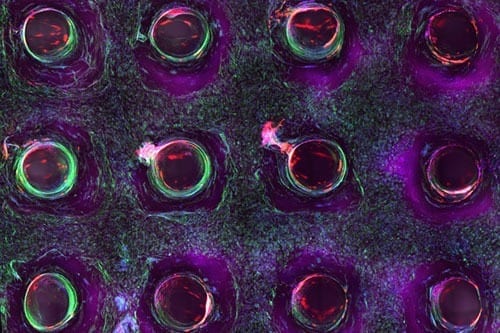
On your car windshield, ice is a nuisance. But on an airplane, a wind turbine, an oil rig or power line, it can be downright dangerous. And removing it with the methods that are available today—usually chemical melting agents or labor-intensive scrapers and hammers—is difficult and expensive work.
That could soon change thanks to a durable, inexpensive ice repellent coating developed by University of Michigan researchers. Thin, clear and slightly rubbery to the touch, the spray-on formula could make ice slide off equipment, airplanes and car windshields with only the force of gravity or a gentle breeze. This could have major implications in industries like energy, shipping and transportation, where ice is a constant problem in cold climates.
The new coating could also lead to big energy savings in freezers, which today rely on complex and energy-hungry defrosting systems to stay frost-free. An ice-repelling coating could do the same job with zero energy consumption, making household and industrial freezers up to 20 percent more efficient. The coating is detailed in a new paper published in the journal Science Advances.
Made of a blend of common synthetic rubbers, the new formula marks a departure from earlier approaches to icephobic coatings, which relied on making surfaces either very water repellent or very slippery.
“Researchers had been trying for years to dial down ice adhesion strength with chemistry, making more and more water-repellent surfaces,” said Materials Science and Engineering graduate student Kevin Golovin. “We’ve discovered a new knob to turn, using physics to change the mechanics of how ice breaks free from a surface.”
Led by U-M Materials Science and Engineering associate professor Anish Tuteja, the team initially experimented with water-repelling surfaces as well, but found that they weren’t effective at shedding ice. But during their experiments, they noticed something unexpected: rubbery coatings worked best for repelling ice, even when they weren’t water repellent. Eventually, they discovered that the ability to shed water wasn’t important at all. The rubbery coatings repelled ice because of a different phenomenon, called “interfacial cavitation.”
Golovin explains that two rigid surfaces—say, ice and your car windshield—can stick tightly together, requiring a great deal of force to break the bond between them. But because of interfacial cavitation, a solid material stuck to a rubbery surface behaves differently. Even a small amount of force can deform the rubbery surface, breaking the solid free.
“Nobody had explored the idea that rubberiness can reduce ice adhesion,” Tuteja said. “Ice is frozen water, so people assumed that ice repelling surfaces had to also repel water. That was very limiting.”
The new approach makes it possible to dramatically improve durability compared to previous icephobic coatings, which relied on fragile materials that lost their ice-shedding abilities after just a few freeze-thaw cycles. The new coatings stood up to a variety of lab tests including peel tests, salt spray corrosion, high temperatures, mechanical abrasion and hundreds of freeze-thaw cycles.
The team has also found that by slightly altering the smoothness and rubberiness of the coating, they can fine-tune its degree of ice repellency and durability. Softer surfaces tend to be more ice repellent but less durable, while the opposite is true for harder coatings. Golovin believes that that flexibility will enable them to create coatings for a huge variety of applications.
“An airplane coating, for example, would need to be extremely durable, but it could be less ice-repellent because of high winds and vibration that would help push ice off,” Golovin said. “A freezer coating, on the other hand, could be less durable, but would need to shed ice with just the force of gravity and slight vibrations. The great thing about our approach is that it’s easy to fine-tune it for any given application.”
Learn more: Spray-on coating could ice-proof airplanes, power lines, windshields
The Latest on: Ice repellent coating
[google_news title=”” keyword=”Ice repellent coating” num_posts=”10″ blurb_length=”0″ show_thumb=”left”]
via Google News
The Latest on: Ice repellent coating
- Ice Cream Coating Market: Projected to Surge to a Market Worth of US$ 4,819.0 Million by 2033 – A Thorough Examination of Industry Evolutionon May 8, 2024 at 8:03 am
Ice cream Coating Market is set to hit US$ 4,819 Million at CAGR of 3.3% during forecast period of 2023 to 2033 ...
- Insect Repellent Buying Guideon May 2, 2024 at 5:00 pm
Our insect repellent ratings identify which products work best against these bugs. (We currently don’t systematically test our products against ticks, but past test results indicate that ...
- The Best Mosquito Repellents of 2024, Testedon April 25, 2024 at 12:27 pm
The latter can ruin your summer fun with constant swatting and eventual itching. Mosquito repellent can save the day, or it can leave you coated in smelly bug spray and still itching from bites. To ...
- The Best Mosquito Repellents for Camping of 2024on April 25, 2024 at 5:54 am
Learn More › Mosquitoes don’t just suck blood, they also suck the fun out of camping, and if you want to prevent both, you’ll need a mosquito repellent for camping. Repellent comes in various forms ...
- The Best Tick-Repellent Clothing to Ward Off Big, Bad Bugson April 17, 2024 at 3:07 pm
We’ve put together a primer with a long list of the best tick-repellent clothing and accessories ... long-lasting Permethrin coating that is microencapsulated, which allows for gradual release ...
- The Best Bug Repellentson April 13, 2024 at 8:25 am
Clean Feel Aerosol Insect Repellent to our list of effective repellents ... Sawyer recommends taking each item outside and coating it until the moisture causes the fabric to darken.
- The Best Winter Jackets of 2024on March 1, 2024 at 4:39 pm
It’s a bit of a shorter cut than other jackets we tested, but that allows for optimum movement outside for anything from ice climbing to building the ... A solid DWR (Durable Water Repellent) coating ...
- How to Choose the Right Car Windshield Wiperson May 31, 2023 at 2:35 am
Performance Features: Consider additional performance features that can enhance the effectiveness of your windshield wipers: Water Repellent Coating ... blades can prevent ice and snow buildup ...
- 10 Mosquito-Repelling Plants You Need in Your Backyardon April 24, 2022 at 5:00 pm
As a bonus, plants that smell terrible to mosquitoes smell great to humans, so your patio will be enhanced by both the natural mosquito repellent and the sweet scent of flowers. These are the best ...
- Nonstick Coatings Informationon February 11, 2018 at 7:07 am
Fabrics or architectural surfaces coated with a low surface energy coating or repellent will repel water, rain, ice, dirt, and soils. Oleophobic repellents will repel oils, alcohol, and grease.
via Bing News












